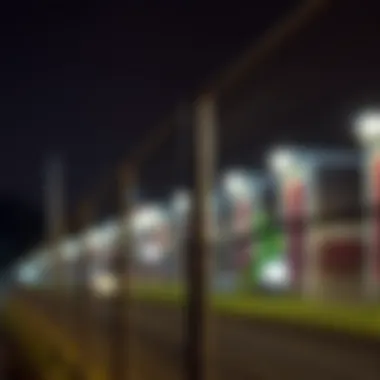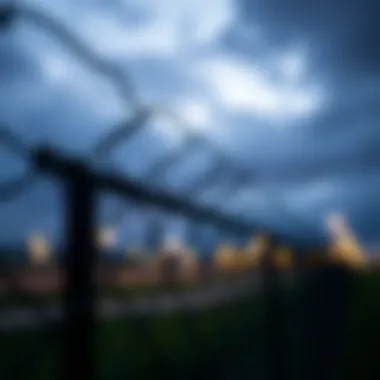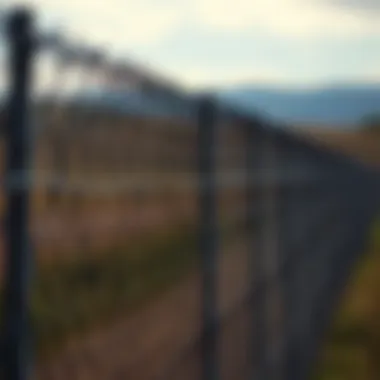Comprehensive Guide to Chain Link Fencing Costs


Intro
When it comes to establishing boundaries for your property, chain link fencing stands out for its affordability and durability. However, understanding the overall costs involved in installing chain link fencing requires diving into several factors. From the types of materials used to labor considerations and ongoing maintenance, there’s a myriad of elements that play into the expense. This guide lays out the important pieces you need to think about, ensuring that any investment you make is a well-informed one.
Factors Influencing Costs
Materials Selection
Chain link fences can be crafted from various materials, each influencing the price differently. The most common is galvanized steel, which is both affordable and resistant to corrosion. However, for those seeking sturdier options, aluminum or vinyl-coated chain link may be favorable; keep in mind that these materials often come at a higher cost. Here’s a brief overview:
- Galvanized Steel: Economical and durable, great for most residential uses.
- Aluminum: Light and rust-resistant, but can be pricier.
- Vinyl-Coated: Offers aesthetic benefits and enhanced durability, but will stretch your wallet.
When considering materials, think about where your fence will be located. Proximity to saltwater environments can also dictate certain material choices due to corrosion.
Installation Costs
Labor plays a critical role in the total cost. Hiring professionals may make the process smoother, but it also represents a substantial portion of your budget. Factors affecting labor costs include:
- Geographic location: Installation costs can vary based on local market conditions.
- Site preparation: If your yard requires clearing or grading, expect extra charges.
- Complexity of installation: A more intricate design or terrain can drive labor costs higher.
It’s not just about hiring skilled technicians; you also want to ensure they have a good reputation and track record. You would not want to pay for shoddy installation.
Maintenance Considerations
After the initial installation, remember to factor in ongoing maintenance. Chain link fences require minimal upkeep, but it doesn’t mean they’re maintenance-free. Regular inspections, occasional cleaning, and addressing any rusting can prevent larger issues down the road. It’s wise to plan for these so that the overall costs do not catch you off guard.
Cost-Effective Solutions
Finding ways to save on chain link fencing doesn’t mean you have to sacrifice quality. Here are some cost-effective strategies:
- DIY Installation: If you're handy, consider installing the fence yourself using kits available from home improvement stores.
- Buying in Bulk: If there’s a larger project on the horizon, buying materials in bulk can lead to significant savings.
- Seasonal Discounts: Look out for promotions during off-peak seasons when fence contractors might be more eager to fill their schedules.
"A little planning can save a lot of money in the long run." – Financial Wisdom
Finale
To sum up, understanding the costs associated with chain link fencing is not just about the price tags. It’s about evaluating your specific needs and making smart choices based on material, location, and installation methods. By doing your homework and carefully weighing your options, you can secure a fence that meets your requirements without breaking the bank.
Prelims to Chain Link Fencing Costs
Chain link fencing is often seen as a practical and economical solution for both residential and commercial properties. Gaining a firm grasp on the costs involved in installing such fencing can lead to better decision-making. Pricing might seem straightforward at the surface, but it can spiral into a maze of factors that require careful consideration. This section lays the foundation by introducing the key elements that influence chain link fencing costs and discusses the benefits of understanding these intricacies.
Overview of Chain Link Fencing
Chain link fencing consists of a woven wire mesh, typically constructed from galvanized steel, which forms a series of interconnected links. This specific design not only enhances durability but also tends to be more cost-effective than other fencing options. Given its open structure, chain link allows visibility and air circulation while still acting as a physical barrier. You might find it near playgrounds, fields, and many backyards across urban and rural landscapes.
In terms of installation, chain link fencing is praised for being quicker to set up than wooden or vinyl counterparts. Its installation doesn’t require any extensive groundwork or heavy-duty equipment, which is an essential factor contributing to lower installation costs. However, those looking to fork out the cash for this type of fencing should understand that, although the initial expenditure might be lower, it is essential to assess long-term benefits and potential maintenance needs.
Importance of Understanding Costs
When approaching the prospect of installing chain link fencing, understanding the costs is indispensable for feasible financial planning. The reasons for this are manifold:
- Budget Management: A comprehensive understanding can prevent surprise expenses that might crop up unexpectedly during the installation process.
- Material Selection: Knowing what influences costs helps in choosing the right materials and gauge, ensuring that one doesn’t overspend on unnecessary features.
- Long-Term Planning: Costs are not limited to installation alone; maintenance requirements can vary significantly depending on the type of chain link used, which could impact budget considerations down the line.
Additionally, older, rust-prone options might require regular upkeep or replacement, undermining initial savings.
Understanding these costs is not merely about avoiding pitfalls but also about grasping potential savings and ensuring that your fencing solution meets both your aesthetic and practical needs.


In summary, diving into the costs surrounding chain link fencing sets the groundwork for informed choices. Whether it’s for securing a playground, protecting an industrial area, or simply enclosing a garden, understanding the economics of your selection can make all the difference. This insight leads the way to smarter investments and ownership satisfaction.
Factors Influencing Chain Link Fencing Costs
Understanding the various factors that influence the costs associated with chain link fencing is crucial for anyone looking to invest in this type of fencing. The expenditure involved can vary widely based on several elements, and gaining insight into these factors can guide you in making well-informed financial choices. By tackling each of these aspects thoroughly, potential buyers can identify the most suitable options that align with their budgets, needs, and property requirements.
Material Quality
The quality of materials plays a pivotal role in determining the overall cost of chain link fencing. When it comes down to it, not all fences are created equal. Investing in high-quality steel or galvanized options can lead to a longer-lasting fence that withstands time and weather, ultimately saving money in the long run.
- Galvanized Steel: This is one of the most common materials used in chain link fences. It undergoes a process to cover steel in zinc, making it resistant to rust. While the initial cost may be higher, it is worth every penny as these fences can stand the test of time.
- Vinyl Coated Options: These offer not just durability but also an aesthetic appeal. However, the costs are generally higher than standard galvanized options. The color options and additional coatings can drive up the price, but they provide an elegant look along with increased durability.
- Recylcled Material: In some cases, you might find chain link fences made from recycled materials, which can be a budget-friendly option. However, it's crucial to tread carefully, as the quality may vary and could potentially lead to higher maintenance costs down the line.
Choosing the right type of material requires a balance between up-front costs and long-term benefits. It’s not just about how much you’re spending now, but what that investment translates to in the years to come.
Height and Gauge of the Fence
The height and gauge (thickness) of the fencing chain link significantly affects pricing. Generally, taller fences and thicker gauges cost more; however, their advantages can often justify the expense.
- Height: Typically, chain link fences come in various heights ranging from 3 feet to 12 feet. Residential fences usually measure about 4 to 6 feet. If your goal includes increased security or privacy, opting for greater heights can enhance both, although it might pinch your wallet a little harder.
- Gauge: The gauge number signifies the thickness of the wire used. A smaller gauge number indicates a thicker wire, which can withstand more stress and last longer. For instance, a 9-gauge wire is stronger than a 11-gauge wire, but you will pay more for that durability. It’s wise to assess the specific needs for your property when weighing these options.
Length of the Fencing Required
Cost estimations can also vary widely based on the total length of fencing required for the project. The more ground you’re looking to cover, the higher the cost will run. When estimating length, it’s vital to consider:
- Configuration: Straight lines may be cheaper to construct. If your yard has a lot of nooks, crannies or curves, expect installation costs to increase.
- Gates: Don’t forget about gates in your calculations! Their sizes and styles add to the total material needed, which can elevate the price. The number and type of gates you choose will matter.
Installation Location
Where the fence is being installed can have a significant impact on overall costs. There are a few layers to this consideration:
- Soil Type: Rocky or hard soil can complicate installation, requiring additional labor and equipment. Conversely, sandy or soft soil is easier to work with and typically lowers installation labor costs.
- Local Regulations: Different municipalities may have varying codes and regulations that require permits, which can add to your costs. A quick call to local authorities can help you understand what you're getting into before diving headfirst into the project.
- Accessibility: If the fence installation location is tricky to get to, then there may be increased labor costs associated with transporting materials and crew to the site.
In summary, acknowledging and understanding these factors influencing chain link fencing costs can empower you to make smarter decisions regarding your investment. The key is not merely to find the cheapest option but to evaluate how various factors play into the overall durability and effectiveness of your fencing solution.
Breakdown of Chain Link Fencing Cost Components
Understanding the breakdown of chain link fencing costs is crucial for anyone considering this fencing option. It allows potential buyers to gain insight into where their money goes and helps in budgeting effectively. Knowing these components can significantly impact the decision-making process, enabling better comparisons with alternative fencing solutions.
Material Costs
Cost of Raw Materials
When diving into the cost of raw materials for chain link fencing, it’s paramount to recognize that these components form the foundation of your fencing investment. The quality of materials influences not only the initial costs but also the longevity and the overall aesthetic appeal of the fence. Typically, chain link fencing is made from galvanized steel, which is known for its durability and resistance to rust and corrosion.
A notable aspect of these raw materials is the wide range of gauge options available. The gauge measures the thickness of the steel, and as a general rule, the lower the gauge number, the thicker and sturdier the material.
You might find that using a thicker gauge steel can hike up initial costs but ultimately results in a longer-lasting fence, making it a worthwhile investment in the long run for those who wish to avoid frequent repairs or replacements.
Shipping and Handling Fees
Shipping and handling fees often catch buyers off guard. These costs can vary greatly, depending on the supplier's location and the distance the materials must travel. Nobody likes unexpected expenses, especially when it comes to a substantial investment like fencing.
One of the primary traits of these fees is their unpredictability. For instance, if you opt for a local supplier, you might save on shipping costs, but ordering from a renowned manufacturer might come with hefty handling fees due to packaging and transport methods.
Additionally, some vendors might offer free shipping on bulk orders, which could lead to considerable savings. Just be sure to weigh the pros and cons; buying more than you need could lead to wastage if not properly calculated.
Labor Costs
Hourly Rates for Installers
Labor costs can often feel like the thorn in the side when budgeting for fence installation. The hourly rates for professional installers can vary based on geographic area, experience, and even the complexity of the job. Typically, you might see rates ranging from $50 to $100 per hour.
Choosing to hire a seasoned installer might cost you more upfront but could save you from costly mistakes down the line.
Investing in a reputable company can also ensure that the installation is done correctly the first time around, further justifying your dollars spent.
Projected Installation Time
Projected installation time plays a vital role in understanding labor costs. An experienced team might finish a job within a day, while a DIY project could stretch over several weekends. If you find yourself deep into a project that drags on longer than anticipated, the labor costs can spiral out of control.
A common expectation is that a straightforward chain link installation takes approximately 1 to 2 days for professionals, depending on the complexity and the length of fencing. This is an important factor to consider, especially if you are working on a tight timeline or budget. While it might feel tempting to cut corners, remember that a rushed installation can lead to costly mistakes, which can make that penny-wise, pound-foolish approach feel rather ill-timed.
Permit and Inspection Fees


Permit and inspection fees are often overlooked in the budgeting process. Depending on the locality, some homeowners may need to obtain permits before starting installation. These fees can vary widely, and in some areas, failing to secure the appropriate permits can lead to fines or the need to remove the fence entirely.
Considering the potential for these unexpected fees, getting familiar with local regulations before the project begins can save both time and money. Often, it's worth reaching out to local government offices or browsing *.gov websites to gather necessary information. Being ahead of the game in terms of local ordinances can shield you from headaches down the road.
A good grasp of all these components not only helps in making informed decisions but also prepares you for a smoother installation process.
Comparative Analysis of Chain Link Fencing Options
When delving into the realm of chain link fencing, conducting a comparative analysis of available options is paramount. This scrutiny not only helps buyers make a savvy investment but also uncovers the nuances that can greatly influence long-term satisfaction with the product. Each type of fencing comes with its own set of pros and cons, which need careful consideration by potential buyers.
Understanding the differences between options, especially between galvanized and vinyl-coated chain link fencing, plays a critical role in assessing overall costs and benefits. Ultimately, the choice shapes not just the aesthetic appeal of a property but also its safety, durability, and maintenance needs.
Galvanized vs. Vinyl Coated Chain Link Fencing
Galvanized chain link fencing, often regarded as the classic option, is created by coating steel wire with zinc. This process shields the metal from rust and corrosion, offering sturdy structure, typically at a lower initial price point. It's an option that many choose due to its straightforward installation and resilience against the elements. However, over time, galvanized fencing may require some maintenance, especially in harsher climates where rust can become a concern if the coating wears away.
On the flip side, vinyl-coated chain link fencing presents a more polished appearance. The vinyl coating adds a layer of protection, enhancing the longevity of the fence and reducing the likelihood of rust or deterioration. While the upfront cost for vinyl options tends to be higher, the aesthetic appeal and reduced maintenance can provide value. Additionally, the variety of colors available in vinyl-coated options can harmonize with the existing landscape, offering a visual edge that galvanized fencing can't quite match.
In summary, when deciding between these two types, it’s essential to weigh initial costs against long-term maintenance expectations and desired aesthetic outcomes.
Heights and Prices Variance
The height of chain link fencing directly influences pricing and application. Standard heights vary from three to twelve feet, and each height caters to different needs—from marking property boundaries to enclosing livestock. Typically, the taller the fence, the higher the price per linear foot. Here's a general rundown of costs associated with different heights:
- 3 to 4 feet (commonly used for gardens and pools): Often the least expensive, these heights average around $10 to $15 per linear foot.
- 5 to 6 feet (good for residential privacy): Prices may range from $15 to $20 per linear foot, striking a balance between visibility and security.
- 7 feet and above (used for commercial or industrial sites): The cost escalates, often exceeding $25 per linear foot, reflecting the increased materials and structural support needed.
It's worth noting that the decision on height should align with the intended purpose of the fence. Higher fences may incur additional installation costs and may require permits, a factor that can notably influence overall expenditure.
To conclude this comparison capture, the choice of chain link fencing, whether galvanized or vinyl-coated, and the height selected play pivotal roles in determining investment efficiencies. Detailed analysis upfront can pave the way for informed decisions that can result in financial savings and optimal fencing outcomes.
Cost-Effective Strategies for Chain Link Fencing
When it comes to investing in chain link fencing, savvy consumers always look for ways to save without compromising quality. Chain link fencing offers durability and functionality, but costs can quickly add up without taking strategic steps. Understanding and implementing cost-effective strategies is paramount for achieving a favorable outcome while protecting your pockets.
DIY Installation Considerations
Opting for a do-it-yourself approach can significantly reduce costs. By installing the chain link fence yourself, you circumvent labor fees that can stack up. However, it’s not as simple as just digging holes and placing posts. Here are a few things to keep in mind:
- Skill Level: Assess whether you have the necessary skills for the task. While chain link fencing is generally straightforward, proper installation is key to ensuring its longevity and effectiveness. Missteps can lead to extra expenses down the road if repairs are needed.
- Tool Availability: Make sure you have access to all the right tools. Things like post hole diggers, a level, and a tensioning device are essential for a smooth installation. Renting tools can be economical but adds to upfront costs.
- Time Investment: Be realistic about how much time you’re willing to invest. While this option may be cheaper, it requires a considerable time commitment, as well as a good amount of physical effort. Consider your schedule and energy levels before diving in.
Benefits of DIY
- Personal Satisfaction: Successfully completing a project on your own can provide a sense of accomplishment.
- Cost Savings: Avoiding labor costs obviously means more money stays in your wallet.
- Customization: You have full control over the design and layout of your fence, ensuring it meets your specific needs.
Bulk Purchase Discounts
Another effective tactic to trim costs involves taking advantage of bulk purchase discounts. By buying materials in larger quantities, you can reap significant financial rewards. Here’s how:
- Material Savings: Many suppliers offer discounts for bulk orders. If you plan to fence a large area, it might make sense to purchase your supplies in bulk. Sometimes, you can save as much as 20%!
- Negotiation Opportunities: When you approach a supplier with a bulk purchase in mind, you might find they’re willing to negotiate further discounts. Building a good relationship with your supplier can also lead to future deals.
- Easier Transportation and Handling: When you buy generously in quantity, you may find it easier to manage logistics, especially if you have a single delivery. This can also help minimize transportation costs.
Points to Remember
- Planning: Make sure to correctly calculate the amount of material needed. Overestimating can lead to excessive purchases and increased costs, while underestimating may leave gaps in your fence.
- Storage: Consider where you will store excess materials until they are used. Keeping them in good condition is crucial.
- Future Projects: If you're planning on further fencing down the road, stockpiling materials can save you money over time.
"Saving money now can lead to bigger rewards later in terms of both finances and satisfaction."
Through careful planning and using these cost-effective strategies, you can successfully navigate the financial waters of chain link fencing. Each step you take to lower costs is a step toward making an informed investment that meets your fencing needs.
Maintenance Costs Associated with Chain Link Fencing


Maintaining a chain link fence is an often overlooked aspect of ownership that can significantly impact long-term costs. As the old saying goes, "a stitch in time saves nine." Proactive maintenance not only keeps your fence looking fresh but can also curb more extensive expenses down the road. Knowing the costs involved in maintaining your chain link fence helps you allocate the right budget and keep surprises at bay.
Regular Maintenance Requirements
The beauty of chain link fencing lies in its durability and low maintenance needs. Nonetheless, periodic upkeep is essential to ensure the fencing serves its purpose effectively. Regular maintenance might include:
- Cleaning: Dirt, mud, and debris can accumulate over time, potentially leading to rust or damage. A good wash with soap and water a couple of times a year can prevent buildup.
- Rust Treatment: It's critical to promptly address rust spots with a wire brush to clean them off. Applying a rust-inhibiting paint can seal and protect metal from further damage.
- Inspection: Routine visuals should be conducted at least twice a year. Look for signs of gaps, dents, or broken sections to catch any issues early.
- Tension Checks: Over time, the fabric may become loose. Make sure to tighten the tension on the wires to ensure the fence remains upright and secure.
Proper maintenance does more than enhance the fence’s aesthetic appeal; it prolongs its lifespan. A well-kept fence can last up to twenty years or more, while neglect can dilute its life expectancy considerably.
Repair Costs
When it comes to repairing a chain link fence, the costs can vary depending on the extent of damage and the materials involved. While minor repairs may not break the bank, larger damages can add up quickly. Here's what to consider:
- Simple Repairs: Fixing a small rusted section or replacing a missing top rail typically ranges from $50 to $100. Often, you can manage these small jobs without professional help, especially if you’re handy.
- Fabric Replacement: If sections of the fence are torn, replacing that fabric can run anywhere from $150 to $350, depending on the length and gauge of the wire.
- Post Replacement: If a fence post becomes damaged, replacing it can be a bit pricier, usually between $200 and $500, depending on the depth and installation requirements.
Ultimately, repair costs are not just about fixing issues as they arise but are also tied into the overall maintenance strategy you choose to employ.
"An ounce of prevention is worth a pound of cure." Investing time and resources in regular upkeep keeps the fences strong and inadvertently saves on costly repairs in the future.
For more information, you can visit resources like Wikipedia on Chain Link Fencing or check out home improvement forums on Reddit.
Understanding these maintenance considerations leads to making informed decisions about the ongoing expenses tied to your chain link fence. It’s wise to factor these costs into your initial budgeting to ensure you’re not caught off guard down the line.
Long-Term Investment Considerations
When investing in chain link fencing, it’s paramount to consider the long-term effects on both your property and your wallet. A chain link fence might seem straightforward and inexpensive at first glance, but understanding its longevity and resale value can give clarity on its actual cost-effectiveness over the years.
Longevity of Chain Link Fencing
Chain link fences are typically designed to last quite a while, usually ranging from 15 to over 30 years if maintained properly. Several factors influence this lifespan:
- Material Quality: Higher quality materials, such as galvanized steel, are far more resilient against rust and wear, extending the fence’s life. It’s wise to invest a bit more upfront for durability.
- Environment: If you live in an area that experience harsh weather, such as extreme rainfall or coastal humidity, the lifespan can be reduced. Regular maintenance becomes even more crucial in these scenarios.
- Maintenance Practices: Simple tasks like periodic cleaning and applying protective coatings can significantly prolong a fence's life. Someone who doesn’t mind rolling up their sleeves can keep their fence looking sharp and functional long past its average lifespan.
To truly maximize this investment, knowing how to properly care for and maintain a chain link fence is critical. A well-maintained fence not only serves its purpose longer but also enhances the aesthetic appeal of the property.
Resale Value Implications
One of the most practical considerations to take into account is how a chain link fence affects property resale value. While chain link fencing is not often seen as a premium choice, it does come with its set of advantages:
- Functionality and Security: Many homebuyers appreciate the added security of a fence, which can differentiate your property in a competitive market.
- Cost-Efficiency: Chain link fencing is generally less expensive than wood or vinyl fencing, making it an attractive option for budget-conscious buyers.
- Visual Appeal with Treatment: Although often considered less attractive, a little creativity can go a long way. With options like vinyl coatings or combining greenery with the chain link, the fence can be made to complement the property rather than detract from it.
Ultimately, while it may not fetch the highest price during a property sale, it certainly doesn’t detract from it significantly either. In some cases, a sturdy, functional chain link fence can even become a selling point.
"When weighing the costs, consider not just the initial outlay, but also the long-term benefits of durability and potential property value enhancement."
In summary, the longevity and resale considerations of chain link fencing provide a comprehensive understanding of the investment. A chain link fence can be seen not merely as a boundary but as a long-term asset if tended to with care and thoughtfulness.
End: Making Informed Decisions
When it comes to installing chain link fencing, understanding the costs involved is vital for anyone considering this option. This article has navigated the maze of pricing, ensuring that potential investors grasp the multifaceted nature of expenditure associated with chain link fences. The objective isn’t just to inform; it’s about empowering you to make sound choices that align with both budget and expectations.
Summarizing Key Cost Factors
Several elements come into play when calculating the total costs for chain link fencing. Here’s a concise recap of those factors, presented clearly:
- Material Quality: The difference between galvanized and vinyl-coated fences isn’t just aesthetic but also influences longevity and pricing.
- Height and Gauge: Variations in height and thickness (or gauge) will directly affect material costs; heavier gauges are typically more expensive but offer greater durability.
- Length of Required Fencing: The more footage you need, the higher the overall price will be, but it’s essential to consider how that fits into your specific project’s scope.
- Installation Location: Geographic and environmental variables can affect labor rates and ease of installation. For instance, rocky soil may require extra effort and equipment, impacting the overall cost.
These segments cannot be stressed enough; a clear grasp of these factors enables investors to project their budget more accurately, avoiding unexpected financial pitfalls down the road.
Final Recommendations
In piecing together these insights, a few recommendations emerge that can guide your decision-making process:
- Do Your Homework: Research local fencing costs, labor rates, and any necessary permits. Familiarizing yourself with market trends will provide a solid foundation for negotiations.
- Consult Experts: Whether it’s a contractor or a fencing specialist, ask questions. Their insights regarding installation and material choices may uncover options you hadn’t considered before.
- Consider Long-Term Value: Cost is important, but value is king. Sometimes spending a bit more upfront on durable materials will save you headaches and expenses in the future depending on local climate and usage demands.
- Explore DIY Options Cautiously: If you’ve got the skills, a do-it-yourself approach can save money, but ensure you have a realistic understanding of the required effort and expertise to avoid costly mistakes.



